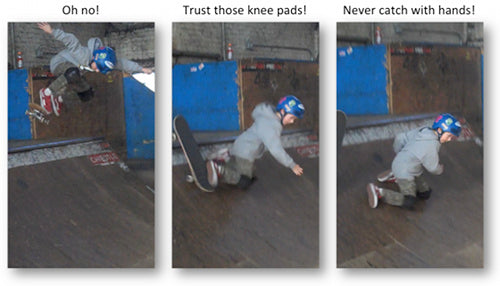Tips for Kids: How to Fall Safely on a Skateboard
The fact is that falling is part of skateboarding. I’m guessing this statement is really obvious to some and surprising to just as many. Skateboarding is NOT about getting good enough so you don’t fall anymore. There are always new tricks, new obstacles, new tweaks and ideas for the young skater to try, falls are inevitable.
The good news is that kids can be taught pretty quickly how to fall correctly, minimizing their chances of getting hurt. The more comfortable your child is falling, the more comfortable they will be trying new obstacles and tricks. The best young skaters out there are excellent at falling, I promise!
The key to a safe fall is to elongate the period of time between initial impact and coming to a complete stop. Hmm, said another way, avoid the Slam, the abrupt and immediate hard contact with the ground, whenever possible. The best ways to accomplish this are to either slide, roll or run it out.
Warning: trying to “catch” oneself with arms outstretched is never a good idea. Wrist injuries are the #1 injury in skateboarding because many skaters didn’t learn to fall correctly. You’ll find some debate as to the value of wrist guards due to this concern. One perspective is that these types of “catch” falls are inevitable so the wrist guards should be there to protect. The other perspective is that wearing the guards will inadvertently encourage the skaters to catch themselves with their hands. One option is to ensure the skater wears the wrist guards while also encouraging them to practice proper techniques in parallel.
Rolling and running it out tend to be the methods that you see older street or park skaters using, for instance on TV during competitions such as the X-Games or Dew Tour. These guys simply don’t wear pads and given that they are falling on concrete, their best bet it to start running midair and try their best to land on their feet and keep moving. If there is no way to run it out they will tuck and roll just like a gymnast. If they are stuck landing on their back they will tuck their chin and hope for a bit of a slide.
If you watch the vert ramp skaters (like Tony Hawk or Shaun White), you’ll be relieved to see that most of these skaters are thankfully still wearing pads and helmets. As running on the halfpipe doesn’t work so well, these guys have mastered the slide. The skaters fall preferably on their knees, sometimes on knees and elbows, occasionally just a slide on the backside.
We recommend that younger skaters always wear their helmets and pads and first and foremost master the ability to slide on their knees. This technique can be used in all sorts of situations on many types of ramps and obstacles and even flat ground.
A skater can get used to the slide by literally kneeling at the edge of a ramp and then sliding down the ramp on their knees. They can also run up a ramp and slide back down backwards on elbows and knees. Eventually they can even jump from the top into the ramp and slide on their knees. These same concepts can be adapted to flat ground. A skater should be able to go from a normal run to sliding safely on their knees without hesitation.
All the above can and should be practiced, even without the skateboard. These techniques really should become second nature to the skater.

Above is a sequence of a safe fall from Zyler, honestly this wasn’t staged for this article, but I was really happy when I stepped through the video and found how naturally Zy transitioned from his attempted backside 180 to a safe falling position, and especially how he pulled his hand back and out of a “catch” position.
Skaters will adapt all sorts of different slide techniques. Some look like baseball slides that can often leverage at least one knee pad and an elbow pad. Other times it is pure backside slide. Most importantly the slide is helping to dissipate the impact of the fall. Again, rolling or running are perfectly viable, we’ve just seen younger skaters learn the slide much more quickly.
In our perspective it just doesn’t make sense for a younger skater not to wear a helmet and pads. As such, learning to slide is our recommended technique. We do not recommend knee slides if your skater isn’t wearing knee pads.
This article is just a start. Skaters will learn a lot from watching what works well for others skaters. Please share any tips or techniques that have worked well for you and your skaters!
